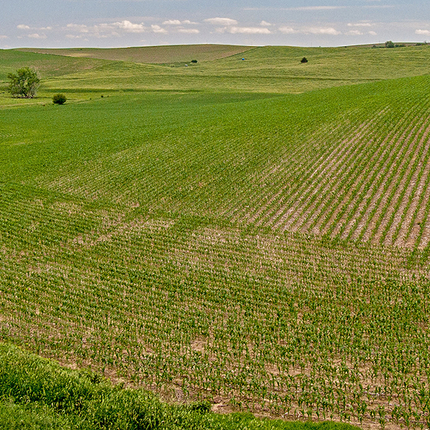A lot of you want to see more family farms and ranches and more businesses in our rural communities. You also care about healthy food and clean water. But if you’re not a farmer, and I say the words “crop insurance,” those words might just go in one ear and out the other. Well, guess what: crop insurance has everything to do with the viability of family farms, the health of rural communities, production of healthy food and stewardship of clean water.
But how? What is crop insurance and how is it connected to the kinds of decisions farmers make, with the kinds of farms we have on the landscape?
First, we have to understand why we have crop insurance. We know farming is risky for many reasons: weather and markets can be unpredictable, and they have huge impacts on annual profits. With crop insurance, farmers can manage this risk by filing a claim and getting a payment at the end of a bad season.
This risk is generally regional: if one farmer in an area battles drought, probably all the neighbors do too. When everyone brings in a claim at the same time, the insurance company faces steep payouts. The federal government decided it was important to help farmers and insurance companies manage some of this risk, so it subsidizes crop insurance by supporting insurance companies and paying a portion of farmers’ crop insurance premium.
Cap benefits to make things even
Still with me? Unfortunately, there’s a major problem with this setup: the nation’s largest and wealthiest farms can insure against a greater level of production risk than smaller farmers can, giving the largest producers a financial advantage. Even though other federal programs have payment limits, there aren’t any limits to what the government will pay on crop insurance premiums. Right now, if one operation farmed the entire state of Iowa and wanted to buy crop insurance to cover all of it, the federal government would cover 62 percent of their crop insurance premiums for every single acre. This undermines the financial health of our nation’s small and mid-size farmers.
We believe a change in policy is needed to level the playing field for small and large farmers. There are a variety of ways to tackle this, such as capping subsidies, or reducing the amount of subsidy for higher levels of coverage. These measures could make crop insurance accessible to all farmers while removing the advantage that unlimited subsidies offer to some.
Incentivize conservation
Another issue with crop insurance: it represents a huge missed opportunity to encourage farming practices that are good for our soil, water and other natural resources. We know that practices such as planting alternative crops or implementing diverse crop rotations can build soil health, which improves crop outcomes, like increasing drought tolerance and reducing nutrient loss.
It would be fiscally and environmentally responsible to structure crop insurance to encourage conservation practices. At present, most crop insurance policies discourage common-sense conservation practices like crop rotation or crop diversity. We believe this should be reversed.
Crop insurance that works for all
Finally, there are a lot of producers who would like to be able to use crop insurance but aren’t able to access policies that work for them. Crop insurance is very well set up for certain commodity crops - 70 percent of acres protected under crop insurance are planted in corn, cotton, soybeans and wheat. But producers who grow unique crops, who raise organic crops, or who are highly diversified often have a hard time finding crop insurance.
USDA’s Risk Management Agency has been expanding its offerings in these areas - there are more organic policies, and a program called Whole Farm Revenue Protection is designed for diversified operations. But we believe there’s opportunity to improve and expand these programs so they work better and for more farmers. Small producers and historically underserved producers are more likely to raise crops for which there aren’t robust crop insurance offerings. Ensuring that these producers have access to robust crop insurance will help them establish and grow their businesses. Their financial health and presence in rural areas contribute to the strength of rural communities. We believe that making crop insurance available to all producers will be an important step in our work of supporting small and mid-size farms and fighting for vibrant rural communities.
So that’s how you fix crop insurance: cap benefits to the largest farms, incentivize conservation, and expand access to all producers and all crops.
To get involved, email me at [email protected].





